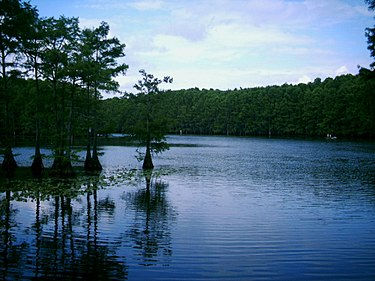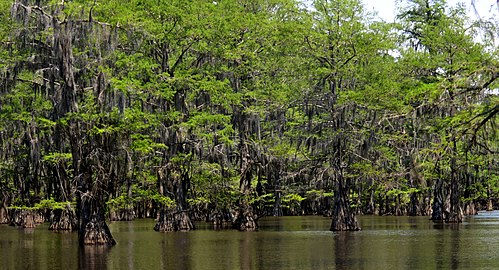
Caddo Lake is known as the only natural lake in Texas and is on the Texas/Louisiana border. It was a short drive from Longview, Texas where I lived and worked for over 30 years. The photo depicts Dick and Charlie’s Tea Room. The house was built some time in the early 1900s. Water taxis and beer boats from Marion and Harrison counties would deliver customers to the house for drinking and dancing. The stilt house is used in the opening scene of the series “True Blood” and was also featured on an episode of “Treehouse Masters.” The sign posted on Dick and Charlie’s Tea Room says: House Rules: There Ain’t None There Never Was None There Ain’t Gonna Be None. Going to Caddo Lake is like taking a step back in time to the Wild West. Its few inhabitants are a motley, independent bunch who don’t always take kindly to strangers, although tourism is a basic industry there. I have taken the Graceful Ghost steamboat ride on Caddo Lake at dusk, and it is hauntingly elegant. Its supernatural beauty is a powerful magnet. I have never seen anything else like it. Let’s learn more about this gem in East Texas.

According to Wikipedia, Caddo Lake is a 25,400-acre lake and bayou or wetland on the border between Texas and Louisiana, in northern Harrison County and southern Marion County in Texas and western Caddo Parish in Louisiana. The lake is named after the Southeastern culture of Native Americans called Caddoans or Caddo, who lived in the area until their expulsion in the 19th century. It is an internationally protected wetland under the Ramsar Convention and includes one of the largest flooded cypress forests in the United States. Caddo is one of Texas's few non-oxbow natural lakes and is the second largest in the South; however, it was artificially altered by the addition of a dam in the 1900s.

Formation According to Caddo legend, the Great Spirit caused an earthquake after one of the Caddo chiefs failed to obey him. The earthquake filled and formed the lake. The earthquake being described in the story is the 1812 New Madrid earthquake. The theory behind the earthquake creating Caddo Lake is that the earthquake's seismic waves caused the ground to sink, which filled up and became the lake. There may be some truth to the legend, as Reelfoot Lake in Tennessee was formed by that earthquake. Most geologists feel the lake was formed — either gradually or catastrophically — by the "Great Raft," a 100-mile log jam on the Red River in Louisiana, possibly by flooding the existing low-lying basin.

History Early inhabitants and exploration The first humans settled in the area near the park around 10,000 BC. For several centuries, these people used the marshlands of Caddo Lake to gather food. Sometime around 800 AD, the first Caddo settlements appeared in the area. At the time, the tribes in the region were not a connected nation, instead being a large collection of close-knit, peaceful gathering communities. Over time, the Caddo communities grew and prospered, becoming a highly evolved farming community by at least 1200 AD, learning to grow crops such as maize or corn. In 1542, the Francisco de Soto expedition, led by Luis de Moscoso Alvarado due to De Soto's death earlier in the expedition, discovered the complex Caddoan society. They sent back the first descriptions of the Caddo. Several more European expeditions explored the area around the park throughout the 1600s. The Spanish established several missions and trading posts during the 1700s, and numerous epidemics caused by the European settlements virtually wiped out the Caddo that inhabited the area. They used the nearby Red River for trading.

1800-1812 In 1800, as part of the secret Treaty of San Ildefonso, Spain — who had been defeated in the Napoleonic Wars — was forced to return Louisiana to France. France regained Louisiana in 1802, two years later. This treaty did not establish the borders of Louisiana, which would lead to issues just a short while later. In early 1803, diplomat James Monroe was sent to France to negotiate purchasing Louisiana from France. Louisiana was bought from France later that year. This was known as the Louisiana Purchase, which doubled the size of the United States. The northeastern part of Texas was thought to be included in the purchase. There was no official border between Louisiana and Texas, which caused disputes between Spain and the United States. In 1806, United States General James Wilkinson and Spanish Lieutenant Colonel Simón de Herrera attempted to negotiate establishing a border between the two nations. On November 5, 1806, an agreement was made to establish the Neutral Territory between the two countries. The Neutral Territory did not have official borders, and the Caddo Lake area was likely located within the territory. Because the territory was not possessed by either nation, neither of them could enforce laws in the territory, so it became popular with outlaws and escaped slaves. In both 1810 and 1812, the two nations sent joint military expeditions into the Neutral Territory to expel the outlaws inhabiting it.

1819-1829
In 1819, the Adams-Onís Treaty was signed, which established the border between Spanish Texas and Louisiana. The border between the two was set along the Sabine River and the 32nd parallel, which placed the Caddo Lake area within the borders of Texas. In 1821, after 11 years of fighting, the Spanish territory of Mexico won its independence. This included the area of the present-day Caddo Lake State Park. Winning the Texas Revolution allowed the Republic of Texas to become independent from Mexico and be annexed by the United States.

1931-1937 The 1931 Texas legislature dedicated state property at Caddo Lake as a public park. Land was donated by various institutions and individuals between 1933 and 1937, the bulk coming from a gift of 385 acres by Thomas Jefferson Taylor II. Civilian Conservation Corps Company 889 began development of the park in 1933. They began building entrance portals, Texas Park Road 2, trails, a shelter house, a boat house, nine cabins, a concession building — currently the group recreation hall, picnic sites, culverts, vehicle bridges and a well house. CCC Company 857 finished the work in 1937.

Natural features of Caddo Lake State Park Caddo Lake State Park is operated as a wildlife management area, a sprawling maze of bayous and sloughs covering 26,810 acres of cypress swamp. The average depth of the lake is 8–10 feet, with the deep water in the bayou averaging about 20 feet. An angler's delight, the lake contains 71 species of fish. It is especially good for crappie, largemouth bass and white bass. Naturalists can enjoy stately cypress trees, American lotus, water lilies, waterfowl, alligators, turtles, frogs, snakes, raccoons, mink, coypu or nutria, beavers, squirrels, armadillos and white-tailed deer.

Preservation efforts In 1993 Caddo Lake preservation entered a renaissance, with the announcement that 7,000 acres of Caddo purchased by the Nature Conservancy were to be merged with the 483-acre Texas Caddo Lake State Park to become the Caddo Lake State Park and Wildlife Management Area. As a result of efforts by the Caddo Lake Institute — co-founded by rocker Don Henley, singer and songwriter for the Eagles, and Dwight K. Shellman — in October 1993, Caddo Lake became one of 13 areas in the United States protected by the Ramsar Convention on Wetlands of International Importance Especially as Waterfowl Habitat, an international treaty for the conservation and sustainable use of wetlands. As of 2003, Caddo Lake flora and fauna consisted of 189 species of trees and shrubs, 75 grasses, 42 woody vines, 216 kinds of birds, 90 fish and reptiles and 47 mammals. One of these species, Crategus opaca or mayhaw, produces fruit which is used for making jelly. Forty-four of Caddo's native species were either endangered, threatened or rare. From 2001 until 2003 Caddo Lake residents fought a legal battle with the City of Marshall, Texas over water rights.

Current threat The lake is currently "under siege" by a fast-spreading, Velcro-like aquatic fern, Salvinia molesta, also known as Giant salvinia. Accidentally introduced to the lake by boaters, the noxious weed doubles in size every two to four days, rapidly killing off life below the surface. Most of the growth of the plant is currently on the Louisiana side, where officials have been focused on recovering from damage caused by Hurricanes Katrina and Rita in 2005. Efforts at removing the weed have included biological means via beetles that normally eat the weed but cannot survive the Texas cold and now include herbicide. The Texas Water Resource Institute's Caddo Lake Salvinia Eradication Project is evaluating multiple methods of eradication.

Texas Bigfoot Since 1965 Texas's Caddo Lake has had hundreds of alleged Bigfoot sightings according to the North American Wood Ape Conservancy, as reported in the Travel Channel 2006 documentary “Bigfoot.”


your reckless use of "motley" is only mildly offensive. I still love you